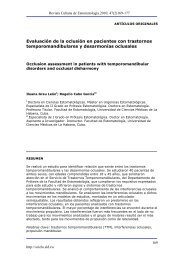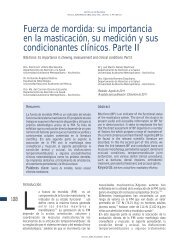o_196r9uot11l8r14n1idc1hovptaa.pdf
You also want an ePaper? Increase the reach of your titles
YUMPU automatically turns print PDFs into web optimized ePapers that Google loves.
Revista Cubana de Estomatología.2010; 47(2)169-177<br />
REFERENCIAS BIBLIOGRÁFICAS<br />
1. Rigoldi L, Duarte MB. Signs and symptoms of temporomandibular disorders in<br />
adolescents. Braz Oral Res. 2005;19(2):34-9.<br />
2. Silva RS, Conti PC, Lauris JR, da Silva RO, Pegoraro LF. Pressure pain threshold<br />
in the detection of masticatory myofascial pain: an algometer-based study. J Orofac<br />
Pain. 2005;19(4):318-24.<br />
3. Gesch D, Bernhardt O, Mack F, John U, Kocher T, Alte D. Association of<br />
malocclusion and functional occlusion with subjective symptoms of TMD in adults:<br />
results of the Study of Health in Pomerania (SHIP). Angle Orthod. 2005;75(2):183-<br />
90.<br />
4. Pahkala R, Qvarnstrom M. Can temporomandibular dysfunction signs be<br />
predicted by early morphological or functional variables? Eur J Orthod.<br />
2004;26(4):367-73.<br />
5. Landi N, Manfredini D, Tognini F, Romagnoli M, Bosco M. Quantification of the<br />
relative risk of multiple occlusal variables for muscle disorders of the<br />
stomatognathic system. J Prosthet Dent. 2004;92(2):190-5.<br />
6. Le Bell Y, Jamsa T, Korri S, Niemi PM, Alanen P. Effect of artificial occlusal<br />
interferences depends on previous experience of temporomandibular disorders.<br />
Acta Odontol Scand. 2002;60(4):219-22.<br />
7. Parker MW. The significance of occlusion in restorative dentistry. Dent Clin North<br />
Am. 1993;37(3):341-51.<br />
8. Gesch D, Bernhardt O, Kirbschus A. Association of malocclusion and functional<br />
occlusion with temporomandibular disorders (TMD) in adults: a systematic review<br />
of population-based studies. Quintessence Int. 2004;35(3):211-21.<br />
9. Sipila K, Zitting P, Siira P, Laukkanen P, Jarvelin MR, Oikarinen KS, et al.<br />
Temporomandibular disorders, occlusion, and neck pain in subjects with facial pain:<br />
a case-control study. Cranio. 2002;20(3):158-64.<br />
10. Fujii T. Occlusal conditions just after the relief of temporomandibular joint and<br />
masticatory muscle pain. J Oral Rehabil. 2002;29(4):323-9.<br />
11. Celic R, Jerolimov V, Panduric J. A study of the influence of occlusal factors and<br />
parafunctional habits on the prevalence of signs and symptoms of TMD. Int J<br />
Prosthodont. 2002;15(1):43-8.<br />
12. Manfredini D, Landi N, Romagnoli M, Cantini E, Bosco M. Etiopathogenesis of<br />
parafunctional habits of the stomatognathic system. Minerva Stomatol. 2003;52(7-<br />
8):339-49.<br />
13. Pahkala RH, Laine-Alava MT. Do early signs of orofacial dysfunctions and<br />
occlusal variables predict development of TMD in adolescence? J Oral Rehabil.<br />
2002;29(8):737-43.<br />
14. Marzooq AA, Yatabe M, Ai M. What types of occlusal factors play a role in<br />
temporomandibular disorders...? A literature review. J Med Dent Sci.<br />
1999;46(3):111-6.<br />
http://scielo.sld.cu<br />
176





